Month: December 2017
On the Perception of Failure: An Essay
Writer—and long-suffering Toronto Blue Jays fan—Stacey May Fowles looks at how success at the highest levels of baseball can still look like failure.
On November 1, 2017, the Los Angeles Dodgers lost the World Series.
Though of course true, to say that “the Dodgers lost the World Series” feels like a strange, glass half empty way to characterize what happened in this year’s baseball postseason. It was, as it always is with baseball, so much more complicated and beautiful than that.
If you were watching what transpired throughout the month of October, you got the sense that all was just and right in the dramatic land of this game—the already anointed “best team in baseball” (the aforementioned Dodgers) faced the compelling underdog (the Houston Astros) in a seven game filmic thriller. Anyone without initial allegiances found it hard to find firm loyalties: both teams definitely felt deserving.
It was the kind of disappointment only possible when a team comes very close, but not close enough.
A more uplifting take on the 113th edition of the World Series would be that the once-excruciatingly terrible Houston Astros won their first championship in franchise history. There was something poetic about them bringing the Commissioner’s Trophy home to Houston, a city ravaged by Hurricane Harvey only a few months earlier. The magic continued when star shortstop Carlos Correa proposed to his girlfriend before he even left the field, and when pitcher Justin Verlander, traded to the Astros minutes before the deadline only a few months before, spent the following weekend in Italy marrying supermodel Kate Upton. When the champagne was drained and the red dust settled, some players went to Disney World, and others went on Saturday Night Live. It was, by all assessments, a fairytale ending.
But after that electrifying seven game series, and a season so often defined by the LA Dodgers’ great expectations, there was a certain degree of notable let down. It was the kind of disappointment only possible when a team is very good, and comes very close, but not close enough.
Nowhere was that feeling more heartbreaking and more acute than in the postgame words of Dodgers’ ace starting pitcher, Clayton Kershaw. “Maybe one of these days I won’t fail, we won’t fail, and we’ll win one of these things,” he told reporters. “There’s only one team that can succeed. There’s only one team that wins the last game, so that’s tough.”
Who among us, in the face of loss, has not felt like the relentless failure regardless of any evidence that disputes it?
The very idea that Kershaw, an elite athlete and arguably one of the best pitchers of his generation, could not only feel like a failure, but basically always feel like a failure is what made that sound bite particularly crushing. It also made his sentiment so human, and so easily identifiable—who among us, in the face of loss, has not felt like the relentless failure, regardless of any evidence behind us that disputes it?
Pitchers are particularly vulnerable to this brand of punishment and self-flagellation, perhaps more than other players on the field. Just ask Kershaw’s fellow Dodger Yu Darvish, who surrendered four runs in both game three and game seven of the World Series, came close to postgame tears, and logged on to Twitter to announce that “the World Series resulted in a disappointment due to my lack of performance.”
If a pivotal game implodes quickly, or even glides gently into the loss column via a single errant walk, wild pitch, or hit, the blame often feels like it lands squarely on the shoulders of whatever man is on the mound. He’s stuck in the spot-lit center of the game, trying not to wear his frustration, until his manager offers him an exit he may or may not want. It’s really no surprise these athletes are prone to various anxiety ailments, crises of confidence, and in some cases—like that of St. Louis Cardinal Rick Ankiel, who famously lost pitching control in the 2000 National League Championship Series and eventually chose the outfield instead—a need to walk away from the game completely.
If Kershaw felt like he has failed, what hope was there for the rest of us?
In Kershaw’s case, the overwhelming evidence of a lack of failure is pretty clear; there were an incredible 104 Dodger wins during the 2017 season, and a Sports Illustrated cover that all-caps asked, “Best. Team. Ever?” Kershaw himself has got three Cy Young Awards, seven All Star distinctions, a Gold Glove, a Triple Crown, and countless other accolades and achievements frankly too time-consuming and tedious to list. So when his sound bite became a headline that circulated among the sports-fan masses, the fundamental question was this; if Kershaw felt like he has failed, what hope was there for the rest of us?
Though many have an understandably escapist attitude towards watching sports, I would argue that what baseball, and sports in general, teaches us about the more difficult aspects of life—loss, disappointment, and yes, failure—is what makes fandom so valuable. Sports forces us to face these difficult realities head on, in an overlarge, stripped down, almost caricature-esque way. It’s always clear who the winners and losers are, the parameters of play becoming a place to safely submerge ourselves in both extreme emotional experiences.
As fans, we voluntarily subject ourselves to the very real risk of not coming out on top, of crying into our ballpark beers, because we understand that the emotional journey is well worth the potential for a less than stellar outcome. Not only do we do this voluntarily, we pay for it—with our time, and our dollars, and our feelings. (During the postseason, I’ve further paid for it with a lack of sleep, poor eating habits, and neglected household chores.) It’s almost as if we understand that it is good for our souls to suffer the losses of strangers, to invest ourselves in something so objectively frivolous, and take it more seriously than we ever dreamed possible.
If you zoom out from the intense, dramatic minutiae of the baseball season’s most important game, Kershaw’s assertion that he is a failure, that he has not succeeded beyond most of our wildest dreams, is completely ridiculous. In fact, the pitcher was up for his forth Cy Young award this postseason, where winning more than three puts you in a coveted circle of historical magnitude. From whatever perspective you choose to come at this by, even that of a dismayed Dodger fan, it’s hard to see him, or the Dodgers, as having “failed.”
Sports fans are doing the work of empathy.
The fact is, if we only ever showed up on game day to win, if that was our only valid measurement of triumph, the enjoyment of play would be a pretty pointless pursuit—especially when, in the MLB for example, you have a one in thirty shot at glory during a pretty good year. And maybe when we as fans acknowledge the sadness and absurdity of a player’s personal disappointment, understand that there is more to a season than that final game, we are actually offering ourselves the same kindness.
The act of loving sports trains us to not only care about the joy of perfect strangers, but also to want to alleviate their pain. In the stands we are developing a kindness and understanding that trophies, parades, and ultimate victories are not the true measure of worth. We are doing the work of empathy, learning to forgive the “failures” of both ourselves and others, learning to become more human—all of which are valuable lessons indeed. ♦
(Photo credit: Image courtesy of Malingering via Flickr.)
Disarm: An Interview
“To make a guitar or to make a violin or to make a drum set we were working very much like cavemen. You know blowing and scratching and banging these pieces of metal, trying to figure out how to make sound with them.”
Artist Pedro Reyes talks about the collaborative effort to produce Disarm Mechanized II (2013). This work, which will be shown as part of the PlayTime exhibition, features musical instruments created out of discarded weapons. When constructing Disarm, Reyes invited musicians to help him design and build the instruments and to compose the music they play in the gallery.
Read the transcript.
Board Gaming the System: A Comic Series
This month, comic duo Adam Bessie and Jason Novak offer us a new spin on the Milton Bradley Company classic The Game of Life.
The Game of Life has always reflected the times, even at the start of its own life, a year before the Civil War. Known first as The Checkered Game Life, Milton Bradley’s seminal game was really just checkers with spots which reflected the values, hopes, and worries of the era: Intemperance, Idleness, Speculation, Ruin, Honor, Suicide, and Happy Old Age (50). Since 1860, every generation has updated Life as a mirror—not of what life actually is, but of what the dominant wisdom tells us it should be. And just what should today’s The Game of Life be?
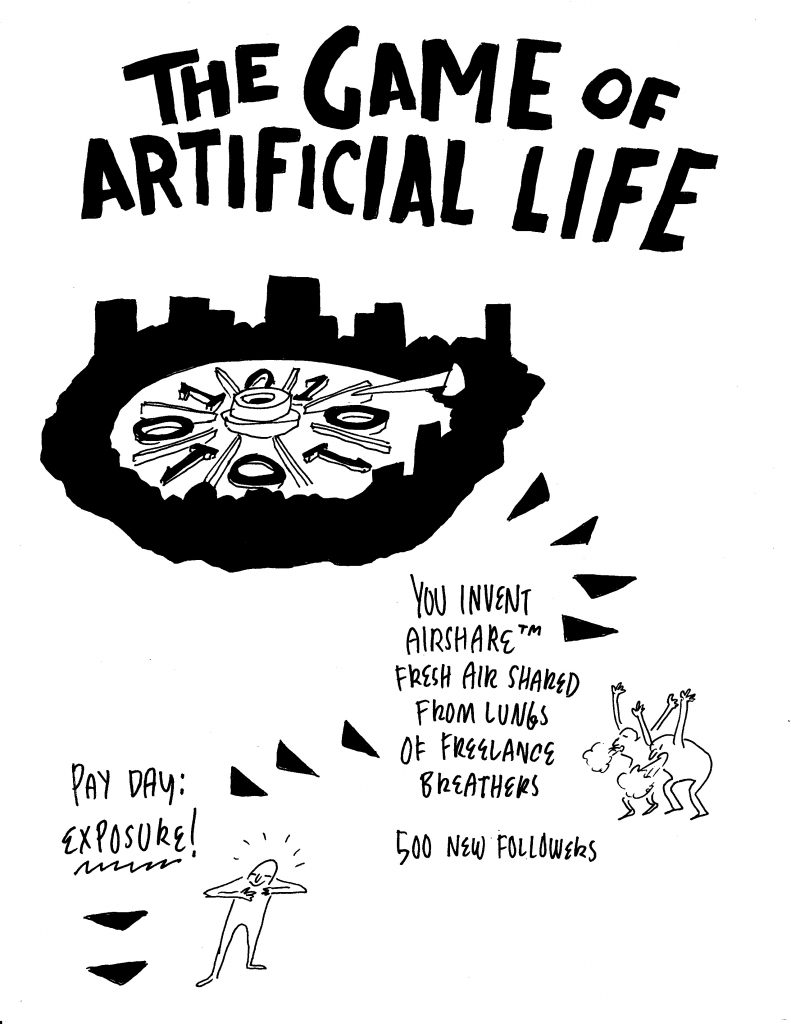
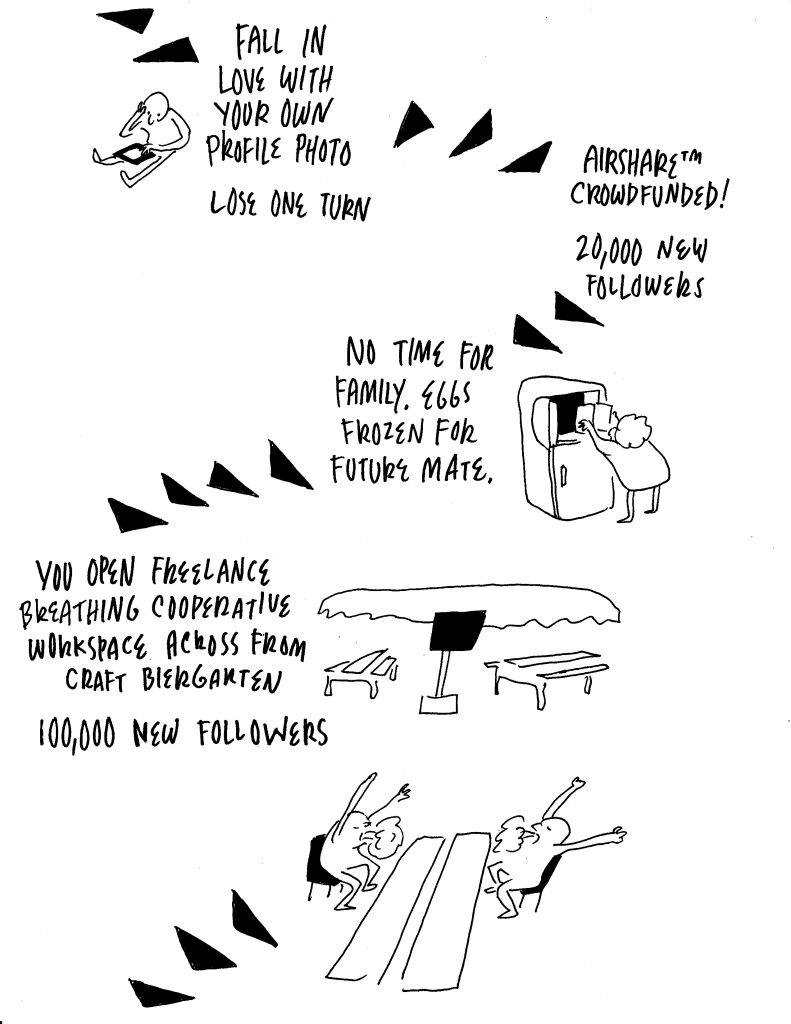

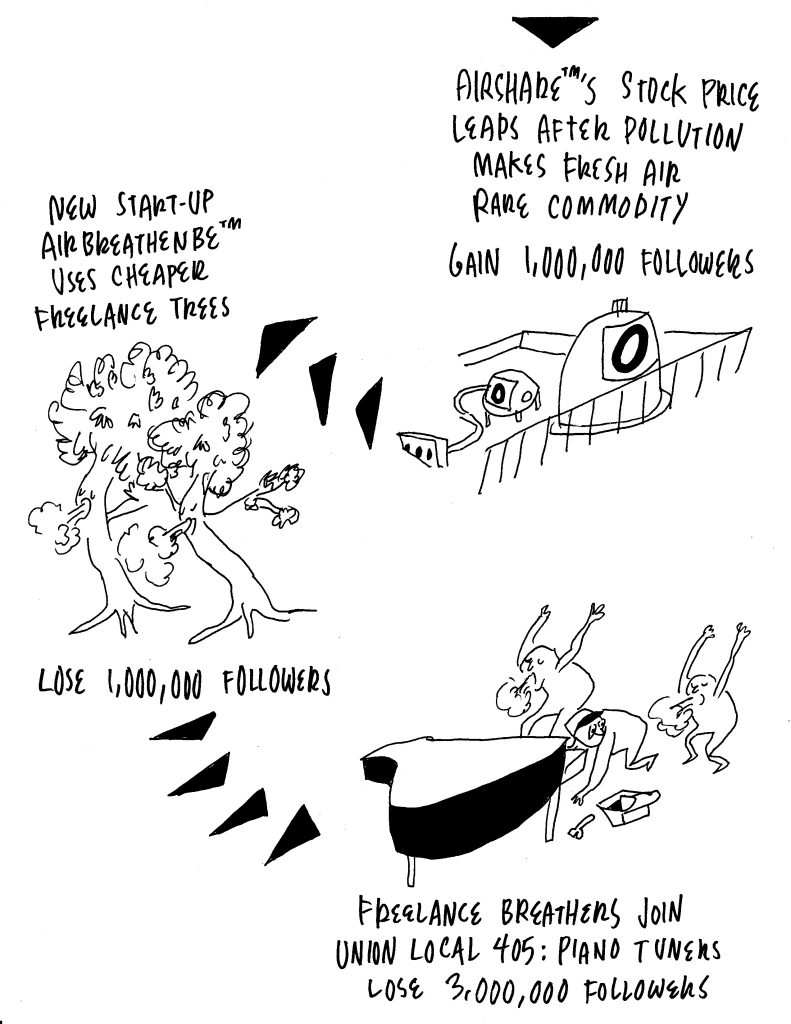
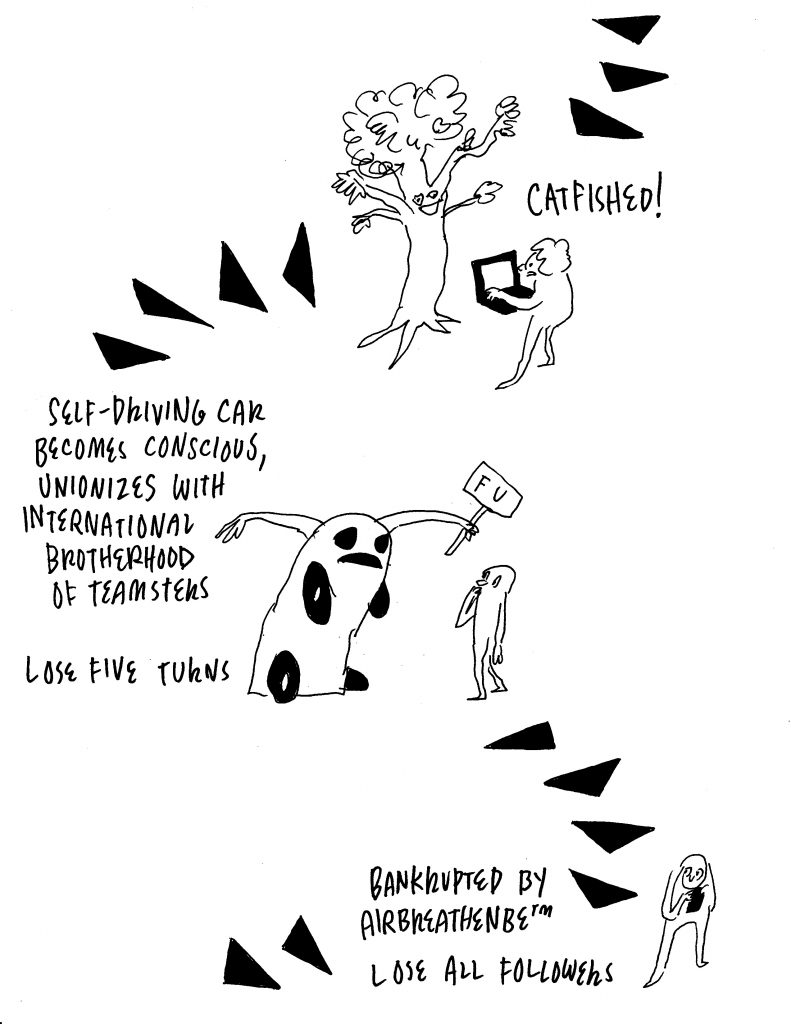
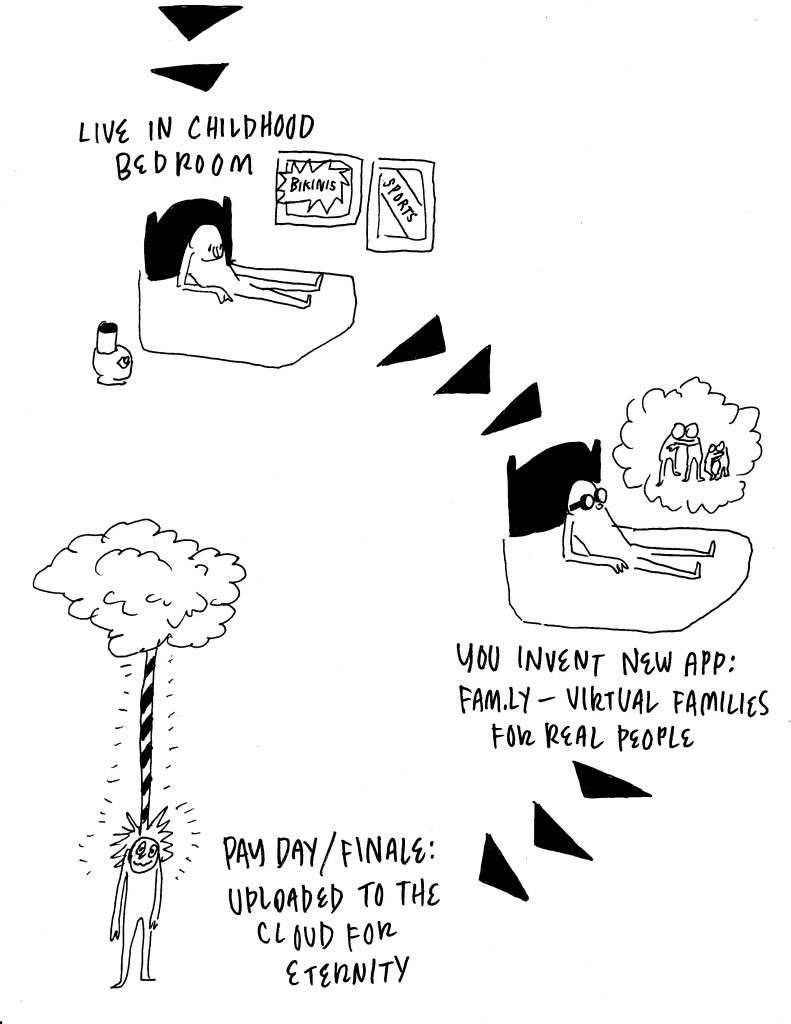
Come back for next month’s installment in the Board Gaming the System comic series. Missed the last one? Check it out here.
Play Digest: Never Bored
Did you know that the first board game, a popular game called senet, came from ancient Egypt? Clearly, this type of play has staying power. Here at PlayTime we’ve already looked pretty closely at the world of board games—Naomi Russo delved into the conflicted history of Monopoly, Charlie Hall researched how the CIA uses board games to train spies, and Carlo Rotella shared his youthful experiences playing war games. This week we roll the dice and take a look at more board game news.
Some like to say that board games are, in fact, experiencing a renaissance. In 2015, the “hobby” board game market grew into a $250 million business. That may answer why (oh why?) Settlers of Catan is being adapted for the big screen.
Eric Zimmerman, who talked to us about the virtues of cheating, and his partners in game design have developed the fun, broad-reaching, and modern Metagame. If the Metagame didn’t already enough of a draw, they’ve developed an expansion pack about games. A kind of meta metagame.
Cards Against Humanity purchases acreage on the US–Mexico border and hires experts on eminent domain to prevent the property from being claimed by the Trump administration for the border wall.
Board games aren’t all simplicity. There is a crop of “tech-centric” board games out there, including an update on the classic Civilization and Pandemic, an interview with the developer of which can be found here.
Where video game industry conventions like the giant E3 and the developer-centric GDC now operate at a level befitting Hollywood or Silicon Valley, the Board Game Convention in Essen, Germany, is open to the general public and introduces the newest in analogue gaming. Ars Cardboard (part of the terrific Ars Technica family) could barely contain its list of the best of the best from this year’s show (TransAtlantic and Altiplano have my vote.).
Check in next week for a new roundup of the latest play news and stories.
(Image credit: Game board and gaming pieces, ca. 1550–1295 B.C., from Egypt, Abydos, Cemetery D. Faience, modern wood. The Metropolitan Museum of Art, New York, Gift of Egypt Exploration Fund, 1901. Courtesy of The Metropolitan Museum of Art.)
Constellation: An Avatar
In December’s video from artist Juliana Horner, she transforms herself before our eyes using makeup and digital effects. This month, we find her persona, Claropsyche, known widely on Instagram, “summoning the highest quality cosmic pearl droplets by any means necessary.”
I feel that in the past, I would have opposed using an app like Photoshop to alter an image of myself. I would have tried to be true to myself, or what I believed to be true to myself. But was I not still ‘editing’ by being selective of the images I chose to share with others? Humanity will always edit; it is our definition of editing that will change over time.
I believe that more people will become comfortable with the idea of digitally editing themselves, unattached to the idea that their physical bodies should match the image they’ve made as technology progresses. Not only does it take much longer to alter the physical self rather versus the idea of self- there are limits. And regardless: is it not thoughts that plant the seed of reality? There would be no car without a preexisting idea of a thing that moves to take you from one place to the other, there would be no videogame without its creator’s fever dream . . . I welcome imagination with open arms. Unreal is real enough for me—better, even.
The Throwback Special: A Story
Novelist Chris Bachelder took inspiration from an infamous 1970s football play (and grievous injury) to spin a story of friendship, ritual, and growing older.
Today in Sports History
November 18, 1985 — Washington Redskins quarterback Joe Theismann, 36, suffers a career-ending compound fracture of the right leg on a sack by New York Giants linebacker Lawrence Taylor during a telecast of ABC’s Monday Night Football. On first-and-ten from their own 46-yard line, early in the second quarter with the score tied 7–7, the Redskins attempt a trick play called a flea flicker. Theismann hands the ball off to tailback John Riggins, who takes several steps forward and then pitches the ball back to Theismann. Theismann looks to throw a deep pass, but he immediately faces pressure from Giants linebacker Harry Carson. “Theismann’s in a lot of trouble,” says play-by-play commentator Frank Gifford. He steps forward into the pocket to avoid Carson, but Taylor, rushing from Theismann’s blind side, leaps onto his back. Theismann ducks, and as Taylor falls and spins, his thigh strikes Theismann in the calf with enough force to snap the bones of Theismann’s leg. “It sounded like two muzzled gunshots,” Theismann says later. Taylor stands quickly, waving to the Redskins sideline for medical help. ABC decides to show the reverse angle replay twice. “And I suggest,” Gifford says before the replay, “if your stomach is weak, you just don’t watch.” “When you see a competitor like Joe Theismann injured, especially this severely, I don’t think anyone feels good about it,” commentator O. J. Simpson says. Theismann receives an ovation as he is carried from the field at RFK Stadium on a stretcher. “I just hope it’s not his last play in football,” says commentator Joe Namath. Jay Schroeder replaces Theismann at quarterback, and the Redskins defeat the Giants 23–21. Theismann, a former league MVP who had played in 163 consecutive games, never plays again.
The hotel parking lot, in which there were no trees, was covered by a thick layer of leaves. The leaves had blown from afar to reach their final resting place. They decayed pungently in pulpy clumps the color of old pennies, impervious now to wind or leaf blower. Beneath this wet stratum of decomposing vegetative matter were the faded arrows, directing traffic flow circularly toward the check-in portico, primarily a nonfunctional architectural gesture of welcome, and only rarely utilized by Old World Europeans and those of very advanced age. The lot was divided by berms, mounded and sparsely coated with bark mulch and cigarette butts. Lights on poles defined the perimeter.
Power lines transected the airspace above the lot. There were few cars in the large lot, and all seemed to have been parked to maximize the distance between them. The rain had begun, its inaugural drops fat and hostile. Vince and Fat Michael stood on a berm, staring upward with attitudes of appraisal and discernment. Vince’s hand still ached from Fat Michael’s handshake. Vince, whose grip was moderate, had attempted, mid-shake, to match Fat Michael’s firmness, and consequently his greeting had been, he knew, restive and undisciplined. At what point, Vince had occasionally wondered, would daily life cease to consist of a series of small threats? What age must he achieve before the large cucumber was stripped of its dark power? Vince and Fat Michael were comparing forecasts for the weekend. Each, as it turned out, had a favorite meteorological website—chosen by chance and maintained by habit—and neither could quite accept the validity of rival predictions. Ignoring the real weather, they squared off about the conjectural weather. Vince scaled the berm to get taller. He suspected Fat Michael’s site was dot-gov. Their forecasts were similar—rain was virtually certain—but each man might as well have been talking to the other about acupuncture or St. John’s wort. Fat Michael rubbed his hands vigorously with antibacterial sanitizing gel.
At what point, Vince had occasionally wondered, would daily life cease to consist of a series of small threats?
Others by now had arrived. Tommy, Carl, Gil, Myron, Gary, Chad. Carl, in a galling violation of an unwritten but commonsense rule of the group, emerged from his extended cab pickup wearing his jersey from last year, that of Giants nose guard Jim Burt. As always, Gary drove in slow circles around the lot, blasting his horn and shouting community-sustaining threats and maledictions. A small school of men darted away from Gary’s car, over two berms toward Derek’s green sedan. After parking, Derek had lifted the hood, and he stood bent at the waist, peering down. Andy, sitting far away in his car with the engine still running, saw the men converge on Derek and his raised hood. The men spread out on the perimeter of the engine, gripping the edge of the car, like zealous spectators at a dice table. There was just enough room for everyone around the warm and possibly defective motor. Their duffel bags lay at their feet. Andy, who may or may not have been hiding here in his running car, turned on his wipers to watch them. They all stared down, nodding. Oh, pistons, oh, hoses! The rain was nasty now, cold and slant. Carl’s Jim Burt jersey was obviously getting wet, forcing his cohorts to decide whether and to what extent Carl was an asshole. Other men arrived, and attended to Derek’s engine: Jeff, Wesley, and Bald Michael, whose nickname, unlike Fat Michael’s, was more or less accurate and non-ironic, though still unkind. Andy watched as the engine summit drew to a close. Derek, always so resourceful, closed the hood and guided the men through the rain toward the protection of the check-in portico. They bowed their heads like monks.
Andy turned off his wipers. He remained in his car with the engine running, pretending to inspect the bottom of his cleats. He held a shoe in one hand, and with the other he used a ballpoint pen to scrape at imaginary dirt around the studs. He had cleaned the cleats carefully earlier in the week, and of course he had cleaned them after the last time he had worn them, a year ago. They were very clean. He wasn’t ready to go inside yet, and he was trying to give the impression to any possible witnesses that he was busy and content here alone in his parked and running car. He cut his engine, not unlike an animal playing dead. He worked earnestly and with renewed vigor at the pretend mud in his cleats.
“‘Hair on a mammoth is not progressive in any cosmic sense,’” George said to Rick, a copyright lawyer for Prestige Vista Solutions. He was in the hotel elevator, returning to his room.
“Okay,” Rick said, looking at his shoes.
“That’s Stephen Jay Gould.”
“Is it?” Rick said.
“What he means,” George said, stepping into the elevator with Rick, “is that there is no inherent or objective value—good or bad—to the woolly mammoth’s thick hair. The hair becomes valuable, or not, only within a specific context or environment. Only in an ice age would hair be favorable. Only in warmer temperatures would it be deleterious. The woolly mammoth is not, cosmically, a fit creature, and neither is its hairless counterpart. Fitness, always, means fitness within particular environmental conditions. It’s not as if you could look at both and predict which one would survive.”
Rick pushed his floor button, then pushed the door close button several times. He shifted his weight back and forth from left foot to right.
A play can take its form—and value and fitness—only within the medium, the crucible, of the adversary’s play.
“Gould provides an interesting analogy,” George said slowly. “So you said, what, that the flea flicker was a horrible call. Well, yes and no. I would argue that you need to consider a play in its context, its environment. And the environment of a play is, to a large extent, the opposing team’s play. A play can take its form—and value and fitness—only within the medium, the crucible, of the adversary’s play. What we call a play in football is actually the reaction that occurs between two plays, which up to the point of the snap are just competing abstractions, just fantasies of domination. To call a play is simply to transmit information.”
George was pacing the car. Rick stared at the illuminated and unchanging numbers above the doors. The elevator stopped, and its doors opened to an empty hallway. Rick resolved to write an online review of these elevators.
“The plays that are called from the sidelines are speculative, abstract. The line of scrimmage is the narrow barrier between those abstractions. When the ball is snapped, the barrier dissolves and the two plays begin to act upon each other. We have confluence! From two plays the play comes into being. Each team’s playbook fantasy takes on terrestrial form. The play lives a fleeting life, like certain unstable isotopes. Each play attempts to assert dominance over the other play, by force and deception. This is why football is the most scientific of sports. A game is a series of discrete experiments. Hypothesis, observation, results, analysis, conclusion.”
Every play is in fact a limitless number of plays, depending on contingency.
The number 5 button was illuminated, but Rick jabbed it eight or nine times. Rick’s simple point in the lobby, which he now regretted making, was that if your quarterback’s bone comes out of his leg during a play, then it was a bad play.
“The Throwback Special was not a priori a bad play. Or what did you say? A dumbshit play. You can’t say it was a dumbshit play merely because it didn’t work. That’s a tautology! The trick play happened to be catastrophically bad on that unseasonably warm evening on natural grass on a first and ten from near midfield against the Giants’ charging linebackers, who were drawn in, it is true, by the handoff to Riggins. And of course one of those charging linebackers was Lawrence Taylor, who was really a kind of player the league had never seen before. Taylor himself could make a lot of teams’ plays seem, what you said, fucking asinine. But every play is in fact a limitless number of plays, depending on contingency. Not just the opponent’s play, but injury, wind and weather, field conditions, crowd noise, execution, personnel, and all of the special properties of the compound that is created by the two constituent plays. Bye. Peace. This was fun.” ♦
(Adapted from The Throwback Special: A Novel by Chris Bachelder. © 2016 by Chris Bachelder. Used with permission of the publisher, W.W. Norton & Company, Inc. All rights reserved. Photo credit: Football field photograph by Daniel X. O’Neil on Flickr.)
Dispatches from the Field: Come Out and Play
“We just want people to have experiences that they think are joyful and fun.”
What happens when a bunch of people get together and design street games for people of all ages? You get the the two-day festival known as Come Out and Play. Held in 2017 in Dumbo, Brooklyn, and on Governor’s Island in New York, Come Out and Play has one primary pursuit: bringing fun outdoors.
Read the transcript.
Play Digest: Dust to Digital
Games are a core part of cultural history and many academics, librarians, archivists, and laypeople have dedicated enormous amounts of time and expertise to ensuring that how we play, and have played, isn’t completely lost to the sands of time. This week we look at who’s collecting and preserving game history, like this, the first video gaming console, the Odyssey.
While the Internet Archive has done yeoman’s work in bringing back the warm fuzzies around Dig Dug, Pole Position, Street Fighter, and something called Return to Zork, the Video Game History Foundation is hard at work making sure that the more ephemeral aspects of video games don’t disappear. Founder Frank Cifaldi envisions a broad digital archive of game packaging, press and marketing materials, source code, and playable binary code, but also a rich library of print material, starting with his own collection of video game magazines.
Similarly, in the UK, the BBC Games Archive has collected, restored, and made available to the public a group of games developed in the early 1980s for the BBC Micro, an early home computer also adopted throughout Britain in schools.
The UK’s Victoria & Albert Museum in London has an outpost in Bethnal Green dedicated to all things childhood, but is known for its stunning collection of British and international board, card, and sporting games, along with dolls and dollhouses, figurines, LEGOs, and so much more.
Meanwhile, in Nuremburg, is the German Games Archive. Founded by a German literature scholar a few hours away in Marburg, the Games Archive is home to 30,000 German-language parlor games dating back to 1945. It even hosts an initiative called Stadt-Land-Spielt! (City-Country-Play!) to “promote games as a cultural asset in society.”
Back in the U.S., the University of Michigan Library has established the Computer & Video Game Archive, which includes a “Serious Games” category dedicated to games “designed for a primary purpose other than pure entertainment.” These include a game from 2011 that teaches players to handle the aftermath of natural disasters and a game that allows users to contribute to scientific research on protein folding.
The LGBTQ Games Archive should be required viewing for anyone interested in the cultural history of gaming or anyone entering the gaming industry. Not yet a fully fledged archive, but rather a resource of “queer game content” in digital games dating to the 1980s, including everything from Super Mario Bros. to Caper in the Castro. Game on, indeed!
Check in next week for a new roundup of the latest play news and stories.
(Photo credit: The Odyssey, the first video gaming console, was manufactured in 1972 by Magnavox. Courtesy of Heinz Nixdorf Museum Forum. Photo by Jan Brown.)
Alex Dimitrov on the PlayTime Manifesto
“For me, play is real freedom. Play is that moment of deep immersion, free of expectations, set apart from ideas, and without investment in an end product tied to capital or structures of power. Play is the real thing. Like when you open your door, thinking to finally check the mail, and you go somewhere else.”
—Alex Dimitrov, poet and Astro Poet
Finish This Sentence: Play Is
“Play is central to the creative process. To have room to play is to have room to say what if?”
We’ve met extraordinary artists, scholars, and fans of play while out and about in the field. We asked them to complete our manifesto and tell us “Play is . . . .” Here are their responses.
Featured in this video are Pedro Reyes, Eric Zimmerman, Jade Ivy, Eric Turiel, Tritemare, Charlotte Richards, Mattie Brice, Travis Larchuk, Jaden D. Francis, Tracy Fullerton, Jane Friedhoff, Sam Roberts, Alioune N’gom, Everett Phillips, Duke DeVilling, Kristen Skillman, Randall Roberts, Amanda Penny, Courtney Price, and Stephanie Barish.
Read the transcript.
(Music by Green North by DKSTR [CC BY-NC-SA 3.0 US].)
Gradient: An Avatar
Artist Juliana Horner, known widely as her persona on Instagram, creates extraordinary makeup effects. She brings her unabashed creativity to us with a special series of videos. This week, a first glimpse.
Horner tells us more: “Times are changing. As technology continues to press into the social realm, the shape of our tools outlines how we create, identify, and PLAY. With quick access to camera and video technology, people around the world are sculpting themselves in ways previously unknown to the darkroom. The makeup industry is booming, and apps used to both define and contort are becoming a fixture of internet culture and self expression. Real-life communication and video game fantasy grow closer each day; in a way, we are each creating our own AVATAR . . . which player are you?”
Here, in the museum: a spectacle! To the melody of “Jupiter, the Bringer of Jollity” from The Planets by composer Gustav Holst.
Look for a new installment from Juliana Horner next month.



